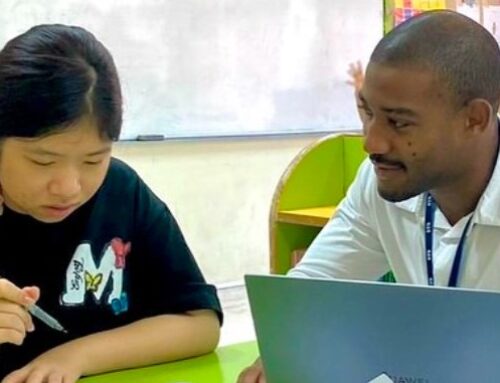So, you’ve just had a bad lesson. Maybe your students were distracted and naughty, perhaps they were half asleep and there wasn’t any energy, or maybe you just couldn’t get them to understand the material.
Now, it’s quite likely that you’re feeling a bit down about it. You’re probably wondering what went wrong or how you will cope with this class for the rest of the term. But shake yourself off and take a deep breath. This is a totally normal part of being a teacher.
Sometimes language lessons just go badly. It happens to even the most experienced language teachers I know from time to time. But it doesn’t mean you are a bad teacher! What you do next is the important part, because there are things you can do to help you bounce back from these challenges and turn them into your most valuable learning experiences.
1. Don’t play the blame game!
If you are teaching in China, then it’s likely that you’re working with young learners. It’s easy to feel frustrated if they have behaved badly or lacked enthusiasm, but it’s important to keep reminding yourself that their brains are still developing. School is a challenging environment for children and teenagers; they’re often under a lot of pressure. So, it’s important that you don’t start blaming them when a lesson goes badly. You are their teacher, and it’s part of your job to create a learning environment where they can excel.
But wait, does that mean it’s all my fault?
No.
It doesn’t matter if you are the greatest teacher in the world, there will always be some classes that are just really hard. That’s okay and perfectly normal. So, don’t blame yourself either. If you tried your best and prepared what you believed was a good lesson, then you did everything you could.
Well, this is all very nice but what should I actually do about it.
2. Reflect and take responsibility
I’m afraid you aren’t off the hook. Blaming yourself for the bad lesson won’t help, but it’s essential that you take responsibility for improving your future lessons. If you go back to the same class next week and do the same thing again expecting something different to happen, then you can be very sure that things won’t get any better.
The bad lesson might be over, but now it’s time to take action. This class is likely going to be one of your best teacher development opportunities.
So, start by reflecting on the lesson. I suggest making some notes as soon as you possibly can. Perhaps even leave a notes section after every lesson plan in your notebook. Your notes should follow a formula something like this:
- What went well in the lesson?
Always start with this. It’s vitally important not to lose sight of the parts of the lesson that went well. The lesson may have seemed chaotic but perhaps the students still actually learnt quite a lot. Chaos doesn’t matter too much if the students still learn.
- What didn’t go well in the lesson?
Stick to the facts. Make it detailed but try not to let frustration interfere with your analysis. Short simple bullet points are best here.
For example:
- “I was explaining the sentence structure, but the students became noisy.”
Or
-
- “I tried to ask questions to check their understanding of past tense, but no students raised their hands.”
- What would I do differently next time?
This is the tricky part. I suggest you do this more slowly and that you take some time to reflect and brainstorm ideas.
You could also go through your lesson plan with two colours. Highlight or underline the sections that went well in one colour and highlight the sections that didn’t go so well in another colour.
This process should give you a fantastic resource for planning your next lesson.
3. Try new things
Now you have prepared some reflection notes you need to go back to the drawing board.
Think about what went wrong in the lesson and research some tips for those aspects of your lesson. It is important that you take some control of the situation and don’t lapse into lazy assumptions like “this class just don’t get it.”
If your students are struggling to grasp the material and you are met with a deafening silence, then consider whether you are going too fast for them. Do you need to give them some easy practice activities before expecting them to use the language independently? Do some research into “scaffolding” for ESL teachers to help you out.
If the students are behaving badly then consider what was happening just before they started to misbehave. Had they done lots of dry writing activities? Perhaps they just need more variety in the types of activity you are giving them. Just google “stirrers and settlers” for some tips on this type of classroom management.
Or maybe you need to re-arrange the classroom. Is there a cluster of difficult students who are disrupting the lesson? Do you need to move some desks? This sort of thing usually only takes five minutes (with some student helpers) and can absolutely transform your lesson.
Perhaps your students looked blank and were unresponsive. Well, maybe they just don’t understand what you’re saying. Often students are embarrassed to admit how little they might have grasped. Questions such as, “Do you understand?” almost never get an honest answer. Graded language for ESL teachers can help you make your communication more accessible.
It might be that your students are bored because you are being too serious. It took me a long time to learn to “loosen up” in the classroom. If you are having fun, then the students will probably have fun too. Embrace the opportunity to be a bit silly and to channel your inner child. It’s one of the things that makes working with young learners so wonderful!
This is obviously a very short list of possible ideas and there are far too many to include in one article, so please don’t be demoralised if none of them work; there are lots of resources online and there are probably some experienced teachers in your school who can help you too.
This brings us nicely to the next point.
4. Get an outsider’s perspective
It’s easy, as a teacher, to feel a bit embarrassed about a difficult lesson. We all want to do a good job and it can feel unpleasant to admit that you’re struggling. However, if you want to become a better teacher then it’s essential that you move past that feeling and start asking for help.
Speak to your colleagues about the issues you are facing and get their tips and ideas. They may well have faced a similar issue in the past and, as they are working in the same school, their advice is likely to be especially relevant to your situation.
As well as speaking to colleagues it’s a great idea to ask another teacher to observe your difficult class. They can attend the lesson in person, or (if school policies allow) you can film the lesson and watch it back with them. This may make you feel a little self-conscious, but it is amazingly useful. They won’t be distracted by having to actually teach the lesson and will likely pick up on some patterns in the lesson that you are just unable to see.
Being observed is a very useful experience but you should also observe other teachers. Make some time in your timetable to observe one of your experienced colleagues and take your lesson notes with you. They will probably have encountered the same issues as you and may have some techniques to deal with them. Your colleague’s classes are also a great place to pick up new games and activities that can help you keep your lessons fresh and interesting.
So, what should I do if I am the only English teacher at my school?
Well luckily, with Teach English In China, you’ll have access to group chats with a whole host of other teachers in a similar situation to you. Reach out to them and start discussing ideas and issues.
You’re also almost certainly not the only English teacher in the city. Join some WeChat groups and make some new friends while also getting some pro teaching tips.
5. Don’t be a perfectionist
Last but not least, don’t expect “perfect” lessons. ESL teaching can be messy at times. That’s perfectly normal.
Sometimes, when you think you have a problem class, you are actually just stressing yourself out when there is nothing wrong. Ask yourself the all-important questions “are the students learning?” and “are they happy and safe?”. If the answer to both of these questions is yes, then perhaps you don’t have a problem after all. The lesson might not be quite what you expected. It might be a bit chaotic and disorderly but if you let go of your preconceptions and focus on simply helping the students to learn, then you can wave goodbye to unnecessary worry.
There is a lasting misconception that students should always sit quietly in neat rows speaking when spoken to and listening attentively to the teacher. Dropping this idea and opting instead for a less rigid classroom atmosphere—it may just be the best thing you can do as a teacher. Just make sure the students learn and keep them happy and safe. Everything else is a minor detail!
Teaching can be challenging at times, but that’s part of what makes it a rewarding and worthwhile career. So, don’t beat yourself up over a bad lesson. But do take responsibility and reflect on what went well and what you should do differently. Keep experimenting and trying new things and don’t be afraid to ask for help from your colleagues.
Teaching has its ups and downs. Bouncing back from bad lessons is a great skill for you to develop, so keep learning, stay positive and have fun!
Ready to take the ESL classroom by storm? Explore our programs or send in an application.
About the author

[/fusion_text][/fusion_builder_column][/fusion_builder_row][/fusion_builder_container]








